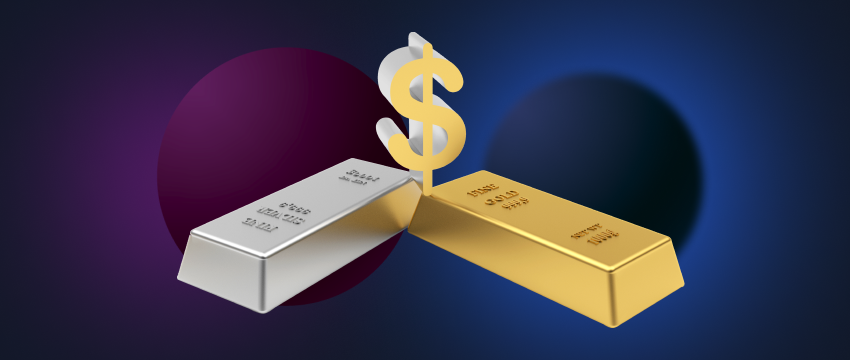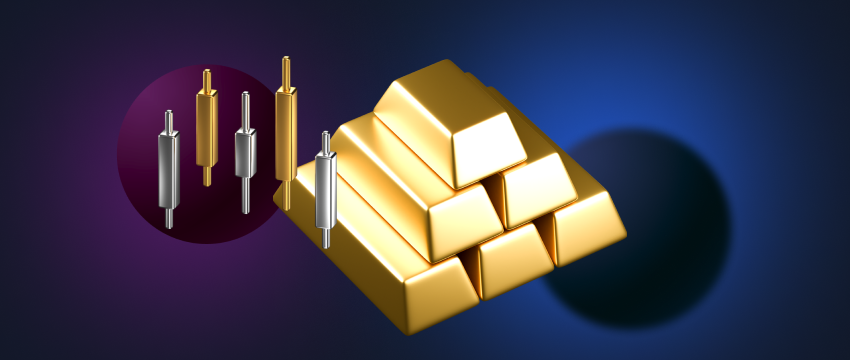Metals play a significant role across multiple industries worldwide, impacting global economies. The value of different metals is largely dependent on their scarcity and their use in sectors such as construction, transportation, manufacturing, and energy. In turn, this has a knock-on effect on metal prices and consequently metal trading. In this article, we’ll explore 5 of the most traded metals in forex in the world.

Metal Trading – Gold
Gold has many notable characteristics that make it an appealing metal to trade:
- It is regarded as a safe haven asset during times of economic or geopolitical uncertainties.
- It is used as a hedge against inflation, political instability, and currency fluctuations.
- It is a finite resource, with limited supply, unlike fiat currencies that can be printed or digitally created. Its scarcity appeals to traders looking to safeguard their wealth from the potential depreciation of fiat currencies.
- During times of recession or inflation, the value of gold typically increases.
- Gold is also used for jewellery manufacturing and in a range of industrial applications. It is often used in the medical, dental, aerospace and defence sectors.
What drives the price of gold?
For one, central bank reserves – particularly as the central banks diversify their monetary reserves away from paper currencies and into gold, typically causing gold prices to rise. Secondly, the value of gold is closely intertwined with the value of the US$ as the metal is US$–denominated. If the dollar strengthens, gold prices tend to go down. Adversely, if the value of the dollar decreases, gold prices usually rise. This is why gold is commonly considered a hedge against inflation.
The demand for gold jewellery and the use of gold in the manufacture of industrial products is a third factor driving the metal’s prices (i.e., supply and demand). Fourth, during volatile market periods, e.g., because of war, economic uncertainty, etc., gold is seen as a safe haven asset.
Metal Trading – Silver
Silver is a sought-after metal due to its unique properties and wide range of uses. Silver is used in a massive array of electronic devices, in the medical field, and for jewellery making. It is considered a store of value and is often used to preserve wealth during periods of economic instability or war. Notably, its value is oftentimes proportional to that of gold.
Factors that influence silver prices:
- Economic trends (whether an economy is growing or moving downwards)
- Stability of the US$
- Supply and demand (industrial use of silver accounts for 65% of the world’s silver supply but it is a finite resource with scarcity influencing prices).
- Inflation impacts most of the world’s commodities. As a result, silver is often used as a hedge against inflation.
- Technological advancements are another factor impacting silver prices. Increased usage of the metal in the electronics sector, 5G networks and even photovoltaics may see demand and thus value grow.

Metal Trading – Copper
Copper is another popular metal for many different reasons, especially for its use across industries. This includes electronics, construction, plumbing and renewable energy. Copper is also renowned for its ties to economic growth, particularly as demand for it expands due to an increase in urbanisation and technological and/or industrial developments. Like gold, copper is also a finite resource adding to its value. In addition, copper is also considered a hedge against inflation, and perceived as a store of value.
Factors impacting the price of copper include:
- Supply disruptions due to political instabilities, labour strikes, natural disasters, etc.
- The availability of alternate metals with similar properties may reduce the demand for copper, thereby impacting prices.
- Higher oil prices that may increase mining or transportation costs, thereby raising copper prices.
- Economic growth, in other words, as an economy expands, the demand for copper usually increases, thereby making prices of copper go up. In contrast, an economic slowdown or recession can result in falling copper prices due to decreased demand for the metal.
Metal Trading – Aluminium
Aluminium is a widely used metal with many uses in different industries. In the transportation industry, aluminium is used for making cars, aeroplanes, ships, trains, etc. Its unique properties (lightweight and strong) have made it a particularly in-demand metal in the manufacture of cars and commercial jets. Aluminium is also a primary component in the production of packaging products (high resistance to corrosion and is highly malleable). The metal is also heavily used in construction.
What factors affect aluminium prices?
- Electricity prices (electricity typically accounts for over 1/3 of the cost of aluminium).
- Production issues (e.g., strikes, closures, etc.) impacting supply and demand.
- International trade (e.g., trade restrictions) as well as government policies and regulations (e.g., tariff charges).
- Changes in exchange rates (the metal is priced in US dollars so as the value of the US$ fluctuates, so too do aluminium prices).
Metal Trading – Platinum
Platinum is one of the rarest metals, demanding a higher price than gold or silver. Despite its scarcity, platinum is an important material required by a number of different industries, in particular the automobile, medical, jewellery and chemical production sectors.
Factors impacting the price of platinum
- Probably the most critical factor driving platinum prices is supply and demand. It is difficult to mine and hard to find, making it one of the most expensive metals to buy. The automotive industry also accounts for almost 40% of the total demand for platinum. As a result, platinum remains pricey.
- Geopolitical events, especially in the countries where platinum is mined. This may lead to supply disruptions, increasing scarcity, thereby raising prices.
- Economic performance, i.e., a growing economy is typically one that sees an increase in industrial manufacturing, leading to an increased demand for platinum which may result in platinum prices going up. An economy facing a downturn may see platinum prices go down due to a slowing down of industry.
- Currency fluctuations also impact the price of platinum which is priced in US dollars. Therefore, as the US dollar increases or decreases in value, so too does the price of platinum ebb and flow.

What are metal CFDs?
In the world of metals trading, 差金決済(CFD) are an incredibly popular financial instrument amongst traders. A CFD is essentially a contract between a broker and a trader that provides a trader with the opportunity to trade metals without having to own the underlying asset. With metal CFDs, the trader will instead speculate on the direction the price of the specific metal (underlying asset) will take and then go long or short. What does this mean? Well, if the trader predicts that the price of the metal will go up, they’ll go long (i.e., buy). Oppositely, if they believe the metal’s price will go down, they’ll go short, meaning they’ll sell.
CFDs are considered a very high-risk investment because they are usually highly leveraged. What is leverage you ask? Leverage is essentially borrowed funds (traders borrowing money from a broker to open larger positions). However, while leverage offers an opportunity for a trader to potentially maximise their profits, it also magnifies losses if metal prices move in an adverse direction. As a result, for those traders using leverage, having proper risk management measures in place to safeguard their capital is vital.
Metal Trading with T4Trade
CFD traders worldwide seek out T4Trade for the flexible trading experience it offers, fast withdrawals and deposits, flexible leverage, and quick execution. T4Trade also provides its traders with exclusive resources to optimise their skills and gain more trading proficiency. A multi-lingual support team is also on hand 24/5 via email, telephone, or live chat to help traders across the globe with any queries they might have.
Disclaimer: This material is for general informational & educational purposes only and should not be considered investment advice or an investment recommendation. T4Trade is not responsible for any data provided by third parties referenced or hyperlinked, in this communication.



